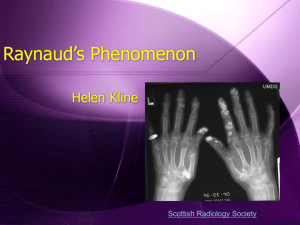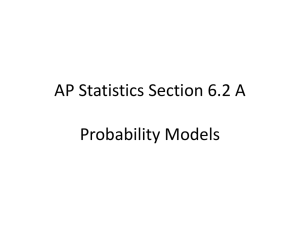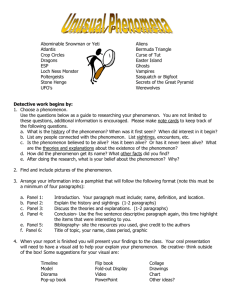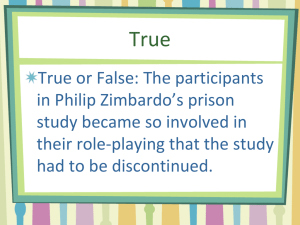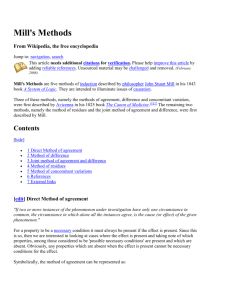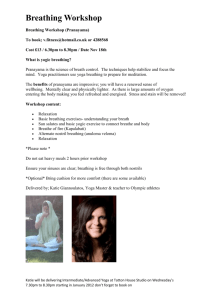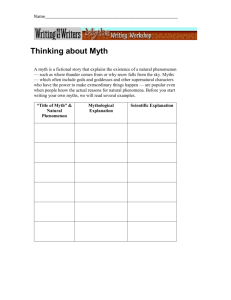Raynaud`s Phenomenon Posted By:- Ian Revins Date:- 19-12-2014
advertisement
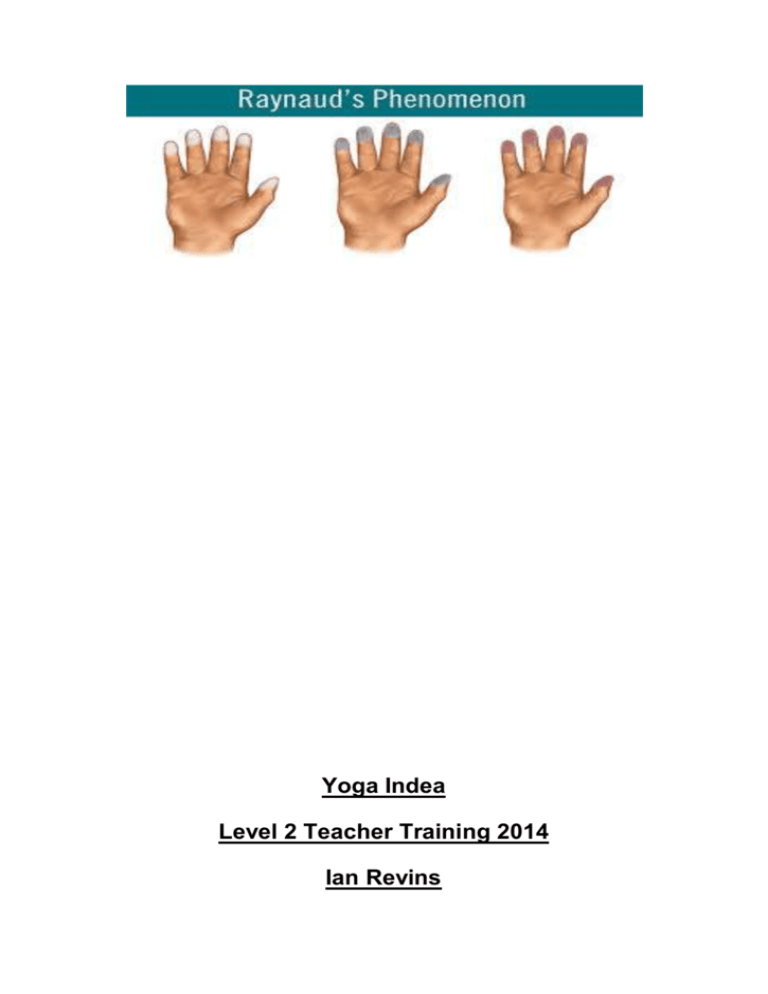
Yoga Indea Level 2 Teacher Training 2014 Ian Revins Introduction Raynaud's phenomenon is a condition resulting in a particular series of discolorations of the fingers or the toes after exposure to cold temperatures and or elevated stress levels. Skin discoloration occurs because an abnormal spasm of the blood vessels causing a diminished blood supply to the local tissues. Initially, the digit(s) involved turn white because of the diminished blood supply. The digit(s) then turn blue because of prolonged lack of oxygen. Finally, the blood vessels reopen, causing a local "flushing" phenomenon, which turns the digit(s) red. The reopening of the blood vessels often causes discomfort such as pain, tingling and numbness. This discomfort can last from just a few minutes to many hours. Raynaud's phenomenon most frequently affects women, especially in the second, third, or fourth decades of life. People can have Raynaud's phenomenon alone or as a part of other rheumatic diseases. Raynaud's phenomenon in children is essentially identical to Raynaud's phenomenon in adults. Different types When it occurs alone, it is referred to as "Raynaud's disease" or primary Raynaud's phenomenon. When it accompanies other diseases, it is called secondary Raynaud's phenomenon. Raynauds phenomenon doesn’t usually cause permanent damage. However, it can be a symptom of a more serious underlying illness. Causes Whit regards to primary Raynauds phenomenon Doctors don’t completely understand the root cause of attacks. What is understood is blood vessels predominately in the hands and feet overreact to cold temperatures or stress. Arteries to the feet and toes go into vasospasm when exposed to cold or stress, narrowing vessels and temporarily limiting blood supply. However for the secondary condition there are a number of underlying disease which can be at the root cause, they include; Connective tissue disease Diseases of the arteries Carpal tunnel syndrome Repetitive action or vibration Smoking Injuries Certain medications Symptoms Symptoms of Raynauds phenonemon depend on the severity, frequency, and duration of the blood vessel spasm. Most patients with mild disease only notice skin discoloration upon cold exposure. They may also experience mild tingling and numbness of the involved extremities that will disappear once the colour returns to normal. When the blood-vessel spasms become more sustained, the sensory nerves become irritated by the lack of oxygen and can cause pain in the involved fingers or toes. Rarely, poor oxygen supply to the tissue can cause the tips of the digits to ulcerate. Ulcerated digits can become infected. With continued lack of oxygen, gangrene of the digits can occur. Less common areas of the body that can be affected by Raynauds phenomenon include the nose, ears, and tongue. While these areas rarely develop ulcers, they can be associated with a sensation of numbness and pain. Patients with secondary Raynauds phenomenon can also have symptoms related to their underlying diseases. Raynauds phenomenon is the initial symptom of a majority of patients with scleroderma, a skin and joint disease. Other rheumatic diseases frequently associated with RP include rheumatoid arthritis, and Sjögren's syndrome. How to diagnose In patients with the characteristic sequence of skin-color changes of the extremities upon cold exposure, diagnosing Raynauds phenomenon is not difficult. Sometimes, certain patterns in the tiny blood vessels (capillaries) adjacent to the fingernails of patients with RP can be seen using a magnifying viewing instrument. Abnormal nail-fold capillary patterns can suggest the possibility of an associated rheumatic condition. There is, however, no single blood test to help the doctor to confirm the diagnosis. The doctor can order certain blood tests (for example, sedimentation rate, rheumatoid factor), antinuclear antibody, thyroid hormone levels, and protein levels) to exclude associated rheumatic diseases and thyroid disorders. Typically, patients with Raynaud's phenomenon that is a manifestation of a rheumatic disease have elevated blood sedimentation rates and antinuclear antibodies. Furthermore, capillary nail-fold abnormalities can frequently be found as described above. Complications In most cases, Raynauds phenomenon has no lasting effects but can have a bearing on quality of life. In severe cases, however, loss of blood flow can permanently damage the tissue. Complications of severe raynauds phenomenon include: Impaired healing of cuts and abrasions Increased susceptibility to infection Ulceration Tissue loss Scaring Gangrene Management and treatment The management of Raynauds phenomenon through yoga is with a complete holistic approach, Incorporating: Asanas Pranayama Kryias Meditation Relaxation Diet Changing of the lifestyle Through these practices the student will gain great awareness and presence of mind releasing stress and tension from the body, while strengthening the neuromuscular system. Releasing stress and tension from the body strengthens and relaxes the sympathetic system which when activated through stress and anxiety cause blood vessels to spasm and contract. All these practices equip the student with the necessary tools to lead a life free from Raynauds phenomenon. This therapy has been designed for a 30 year old female suffer of Raynauds phenomenon, but can be applied to any other sufferer with no other underlying illness. She has been suffering from Raynauds phenomenon for 2 years, the condition is worst during autumn and winter months. Often pain and tingling is present for up to 30 minutes as the blood rushes back to her fingers. The condition also causes the development of chilblains which can be painful and take a long time to heal. She has tried preventive measures of wearing gloves and finger exercises to induce circulation but little relief has been gained. Asana The following therapy series is to be preformed 3 times a day for 3 weeks, the duration of each practice should 30 minutes. Breathing through the nose and coordination of breath and movement cultivate maximum benefit from each asana. Working with awareness is essential to influence, integrate and harmonize all levels of being 1 Joint movements 1.1 toes movements 1.2 ankles rotations 1.3 knees rotation 1.4 waist rotation 1.5 fingers movement 1.6 wrist rotation 1.7 elbows movement 1.8 shoulders rotation 1.9 neck movement 1.10 shitali tadasana 2 Standing breathing 2.1 ankle stretching 2.2 hands in and out breathing 2.3 hands stretching 2.4 front and back bending 2.5 sides stretching 2.6 spinal twist 2.7 parivrtta trikonasana stretching 2.8 shitali tadasana 3 Back movements 3.1 vagra swasa (tiger) breathing 3.2 shashankasana 3.3 bujangasana (cobra) breathing 3.4 makarasana 3.5shalabasana (locust) breathing 3.6 dhanurasana (bow) breathing 4 Supine practice 4.1 Urdva prasaritapadasana (leg raising) 4.2 Setu bandasana (bridge) breathing 4.3 Pavana mukttasana kriya 4.4 jataraparivartanasana (abdominal twist) Shavasana Pranayama Pranayama brings balance to the mind, body and breath. It is a fantastic release from stress and anxiety, and prepares a student well for meditation. The following techniques are tremendously beneficial for Raynauds phenomenon patients: Nadi Suddi – Energy Channel Purification Kapalbhati – Shining Skull Ujjayi - Victorious The practice of these pranayamas should be undertaken as frequently as possible throughout the day for the 1st 3 weeks. Kriyas The effects of kriyas can be summed up in one word, purification. When all the different systems of the body have been purified, blockages and toxins are removed. Opening up pathways of the body, the nadis, the energy body, the mind and the heart. The following techniques are to be incorporated into the therapy once a day: Jala neti Sutra neti Meditation Meditation is very effect as a means of becoming aware of physical, mental and emotional tensions that may have brought about the condition. The following mediations are recommended: Antar mourna Mantra repetition – soham To be practiced at least once a day throughout the therapy. Relaxation Yoga nidra is one of the most scientific methods of relaxation yet devised. It operates at our deepest level of being, releasing those tension which are at the root cause of most of our problems and disease. Yoga nidra is to be practice at least once a day during shavasana. Diet A very light diet of easily digestible foods should be adapted. Choosing fruits, vegetables and whole grains over meats, excessive protein foods, spicy and oil foods. Moderate size meal portions, regular meal times and reframing from eating in between meals reduces the work load on the digestive system therefore liberating energy from digestion into healing. Changing of the life style In cases of Raynauds phenomenon where stress and anxiety can be often at the root cause managing ones day today life and finding time to completely switch off is essential. In modern society people forget to take time off for relaxation and cell rejuvenation. On occasions where time is set aside to rest it often becomes filled with social activities and other events which stimulate the mind instead of relaxing and unwinding. Simple techniques such as setting aside a precise time for meditation/silent sitting, regular sleeping and eating times, dethatching from mobile phones and reducing the amount of tv watched before bed help to create a routine, establishing some stability and reducing fluctuation of the mind. Conclusion Yoga requires time and effort but can produce permanent positive results. In this particular case western medicine has no outright cure, only medication which can sometimes provide temporary relief is available. The intensity of this suggested yoga therapy increases the flow of prana throughout the body, purifying the system and making a change at cellular level. All the prescribed practices collectively relax the mind and strengthen the neuromuscular system which will in turn have a tremendous effect on the sympathetic system stopping any unnecessary activation which leads to blood vessel spasm. For the therapy to be truly effective, the student must be whole heartedly committed to each and every practice, approaching each practice with faith and a positive attitude. The therapy must not be viewed as a chore as this will create a blockage and little progress will be made, instead it must be seen as liberating and healing. After the three weeks of therapy the student’s condition would be assessed and depending on their progress the appropriate adjustments would be made to the therapy. Bibliography www.medicinet.com Fauci, Anthony S., et al. Harrison's Principles of Internal Medicine. 17th ed. United States: McGraw-Hill Professional, 2008. Koopman, William, et al., eds. Clinical Primer of Rheumatology. Philadelphia: Lippincott Williams & Wilkins, 2003. Ruddy, Shaun, et al., eds. Kelley's Textbook of Rheumatology, 6th ed. Philadelphia: Saunders, 2001. www.Mayoclinic.org www.medscape.com www.thehealthchannel.com Yogic management of common diseases – Dr Swami Karmananda Yoga Indea level 1 training manual Hatha Yoga Pradipika – Swami Svatmarama
